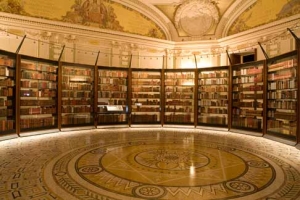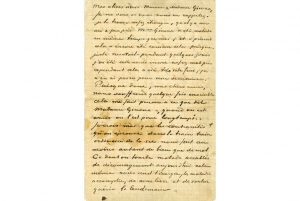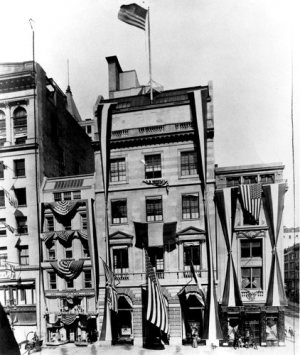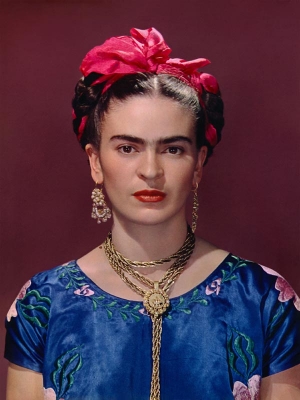|
Displaying items by tag: letters

On May 1, 2013 the Van Gogh Museum in Amsterdam will re-open after being closed for months due to ongoing renovations. The exhibition that will inaugurate the newly updated space is Van Gogh at Work, an extensive overview of Vincent van Gogh’s (1853-1890) oeuvre that happens to coincide with the 160th anniversary of the artist’s birth. What the Van Gogh Museum kept quiet until now is that the exhibition will reveal research amassed during an eight-year analysis of the artist’s work.
The project, which was led by scientists at Shell in collaboration with the Dutch Cultural Heritage Agency and curators at the Van Gogh Museum, entailed analyzing hundreds of van Gogh’s canvases, pigments, letters, and notebooks. The research provided previously unknown insights into van Gogh’s temperament and personality. Contrary to popular belief spurred by the artist’s struggles with mental illness, van Gogh was not a manic painter, but painstakingly methodical. The use of an electric microscope and X-ray fluorescence spectrometry revealed that van Gogh used grids to accurately portray proportions and to create precise depth of field in his early landscapes.
Another insight the researchers uncovered involved van Gogh’s pigments. Tests done at the Shell Global Solutions labs revealed that some of the pigments used by van Gogh were chemically unstable and faded prematurely. In particular, scientists discovered that the color of the walls in van Gogh’s seminal painting The Bedroom was inaccurate. Van Gogh had used red and blue paints to create a violet hue but the red faded, leaving behind a much bluer color than he intended.
Beginning in September, the Van Gogh Museum will exhibit two versions of The Bedroom – one from its own collection and one from the Art Institute of Chicago’s collection. Van Gogh painted three versions of his room in Arles between 1888 and 1889 and all three of them have the same blue-hued walls. The presentation will also include a digital reconstruction of what the painting may have looked like when van Gogh first created it.
Van Gogh at Work will be on view through January 12, 2014.

As part of its Civil War in America exhibition, the Library of Congress in Washington, D.C. is exhibiting the John Hay copy of the Gettysburg Address through May 4, 2013. The manuscript went on view on March 22, 2013 in the Library’s Thomas Jefferson Building. Admission is free and open to the public Mondays through Saturdays.
The Gettysburg Address is one of the best-known speeches in American history. Delivered by President Abraham Lincoln during the Civil War on November 19, 1863 at the dedication of the Soldiers’ National Cemetery in Gettysburg, PA, the Gettysburg Address took place four and a half months after the Union armies defeated those of the Confederacy at the Battle of Gettysburg. The Battle of Gettysburg, which saw the largest number of causalities in the Civil War, is often considered the war’s turning point. Widely recognized as a literary masterpiece, the Gettysburg Address conveys in some 270 words the principles upon which the nation was founded, honors the men who had lost their lives in battle, and asks all citizens to renew their commitment to freedom and democracy.
The John Hay copy of the Address is the second of five known manuscript drafts. Lincoln personally gave the copy to Hay, one of his two secretaries. His other secretary, John Nicolay, is believed to have the first draft, known as the Nicolay copy. Hay’s descendants donated the Hay and Nicolay copies of the Gettysburg Address to the Library of Congress in 1916.
Civil War in America, which opened on November 12 2012, commemorates the 150th anniversary of the Civil War and includes diaries, letters, maps, song sheets, newspapers, photographs, drawings, and artifacts that reveal the complexity of the Civil War through the individuals who experience it firsthand. The exhibition is on view through January 1, 2014.

On March 9, 2013 the Crystal Bridges Museum of American Art opened a sweeping exhibition focused on the work of the widely popular 20th century painter and illustrator, Norman Rockwell (1894-1978). Rockwell is best known for his archetypical portrayals of American life as well as his cover illustrations for The Saturday Evening Post magazine, a job he fulfilled for over 40 years.
American Chronicles: The Art of Norman Rockwell is a traveling exhibition that features 50 original Rockwell paintings as well as the 323 covers the artist created for the Saturday Evening Post. The show features some of Rockwell’s most recognized images including Triple Self-Portrait (1960), Girl at Mirror (1954), and Going and Coming (1947) as well as portraits of presidents Dwight D. Eisenhower and John F. Kennedy. American Chronicles includes a number of pieces from Rockwell’s archives such as preliminary sketches, color studies, photographs, letters, manuscripts, and detailed drawings.
The well-rounded exhibition allows visitors a glimpse into Rockwell’s artistic process and illustrates how he came to be the visual interpreter of day-to-day life in post-World War II America. American Chronicles: The Art of Norman Rockwell will be on view at the Crystal Bridges Museum through May 27, 2013.

California based auction house, Profiles in History, announced today that they will exhibit highlights from their upcoming auction, The Property of a Distinguished American Private Collector. The exhibit will be held at Douglas Elliman’s Madison Avenue Gallery from December 3 through December 9. The exhibit was supposed to be held at Fraunces Tavern Museum, but an alternate location was needed after Hurricane Sandy inflicted a fair amount of damage on the museum.
The Property of a Distinguished American Private Collector includes over 3,000 manuscripts that will be auctioned off at a series of sales beginning on December 18. The first part of the sale will include 300 of the most important letters and manuscripts from the collection and carries an estimate in excess of $8,000,000.
One of the most notable highlights of the exhibition and sale is a four-page handwritten letter by Vincent van Gogh. In the letter written to his close friends, Monsieur and Madame Ginoux, just seven months before his death, van Gogh talks of his failing mental and physical. He writes, “Disease exists to remind us we are not made of wood…” The letter, penned on January 20, 1890, is expected to bring between $200,000 and $300,000.
Other important documents on view include several manuscripts by George Washington, a Thomas Paine manuscript, a rare Emily Dickinson letter, and other correspondences by Sigmund Freud, Carl Jung, Karl Marx, Charles Darwin, and Thomas Edison.

The Getty Research Institute in Los Angeles has acquired a number of 18th and 19th century prints by James Ensor (Belgian, 1860 – 1949) and Jean-Jacques de Boissieu (French, 1736 – 1810). An anonymous collector gifted the works to the museum. “Prints are a significant collecting priority for us,” said Marcia Reed, chief curator of special collections at the Getty. The gift will flesh out the museum’s already impressive Ensor holdings and will add a solid representation of Boissieu’s work.
Among the Ensor prints are three hand-colored etchings that are exceptional examples of his work from the 1890s, the period that is considered to be his artistic peak. Two of the three prints were inspired by Edgar Allen Poe stories and bear the skeletons, masks, and crowds of people that Ensor often included in his work. The Getty already has a compilation of Ensor’s correspondence and manuscripts including 100 signed postcards and letters, 16 prints, and his masterpiece, Christ’s Entry into Brussels in 1889 in its collection.
The gift of Boissieu’s work includes 23 etchings that span the artist’s career. Well-known as a painter and draftsman, Boissieu was also a renowned printmaker and was highly regarded for his work during the 18th century. The collection includes several sheets of Boissieu’s studies of heads – both human and animal.
The Getty Museum plans to host a major, monographic exhibition of Ensor’s work in 2014. The show will include the prints gifted to the Research Institute.

165 years ago, the Knoedler Gallery opened its doors in New York and went on to help create some of the country’s most celebrated collections including those of Paul Mellon, Henry Clay Frick, and Robert Sterling Clark. Throughout the years, top-notch works by artists such as van Gogh, Manet, Winslow Homer, John Singer Sargent, Louise Bourgeois, and Willem de Kooning passed through the gallery. When the Soviet government sold hundreds of paintings from the State Hermitage Museum in Leningrad in the 1930s, they chose to work with Knoedler to sell paintings by masters like Rembrandt, Raphael, and Velazquez.
Knoedler’s exemplary past is often forgotten as the gallery’s present has been mired in lawsuits and accusations that the company’s former president, Ann Freedman, was in the business of selling fakes. Last year, Knoedler Gallery closed its doors for good.
This week, Los Angeles’ Getty Research Institute announced that it had bought the Knoedler Gallery archive. Spanning from around 1850 to 1971, the archive includes stock books, sales books, a photo archive and files of correspondence, including letters from artists and collectors, some with illustrations. The Getty was interested in Knoedler’s archive because it offers an expansive glimpse into the history of collecting and the art market in the United States and Europe from the mid-19th century to modern times.
The archive was purchased from Knoedler’s owner, Michael Hammer, for an undisclosed amount. Meticulously preserved, the archive will be available to scholars and digitized for online research after the Getty catalogues and conserves it all.

While Frida Kahlo is known for her bright and highly personal self-portraits, her role as a style icon is not to be dismissed. Most women of the 1930s embraced form-fitting dresses, coiffed hairdos, and dainty, pencil-thin eyebrows. Kahlo preferred to make appearances wearing ribbons, full skirts, bold jewelry, loose peasant blouses with vivid embroidery, and her signature untamed eyebrows.
A full collection from Kahlo’s wardrobe will go on display at the Frida Kahlo Museum in Mexico City beginning November 22nd. Sponsored by Vogue Mexico, Appearance Can Be Deceiving: The Dresses of Frida Kahlo will include jewelry, shoes, and clothes that had been locked away in the artist’s armoires for almost 50 years.
Smelling of cigarette smoke and perfume and stained from painting, Kahlo’s clothing served as an armor of sorts. Kahlo’s life was rife with pain, both emotional and physical. Polio left one of her legs thinner and weaker than the other, a bus accident maimed her when she was only 18, she suffered multiple miscarriages, and endured a tumultuous marriage with the Mexican muralist, Diego Rivera. Kahlo coped with all of these experiences in her painting as well as through her dress. Her long, full skirts covered her debilitated leg and her loose blouses covered the rigid corsets she wore for back pain.
When Kahlo died in 1954, Rivera ordered that her clothes be locked up for 15 years. After his death three years later, art collector Dolores Olmedo became the manager of his and Kahlo’s houses and refuses to allow access to Kahlo’s letters, clothes, jewelry, and photographs. They were not unlocked until Olmedo’s death in 2004.
Highlights from Appearances Can Be Deceiving include the white corset Kahlo wore in the self-portrait The Broken Column and an earring that was a gift from Pablo Picasso and was featured in a self-portrait from the 1940s. The mate has not been found. A Tehuana dress, named after Indian women of that region, was Kahlo’s signature piece of clothing. Worn with large gold earrings and flowers braided into her hair, the dress is featured in many self-portraits.
|
|
|
|
|